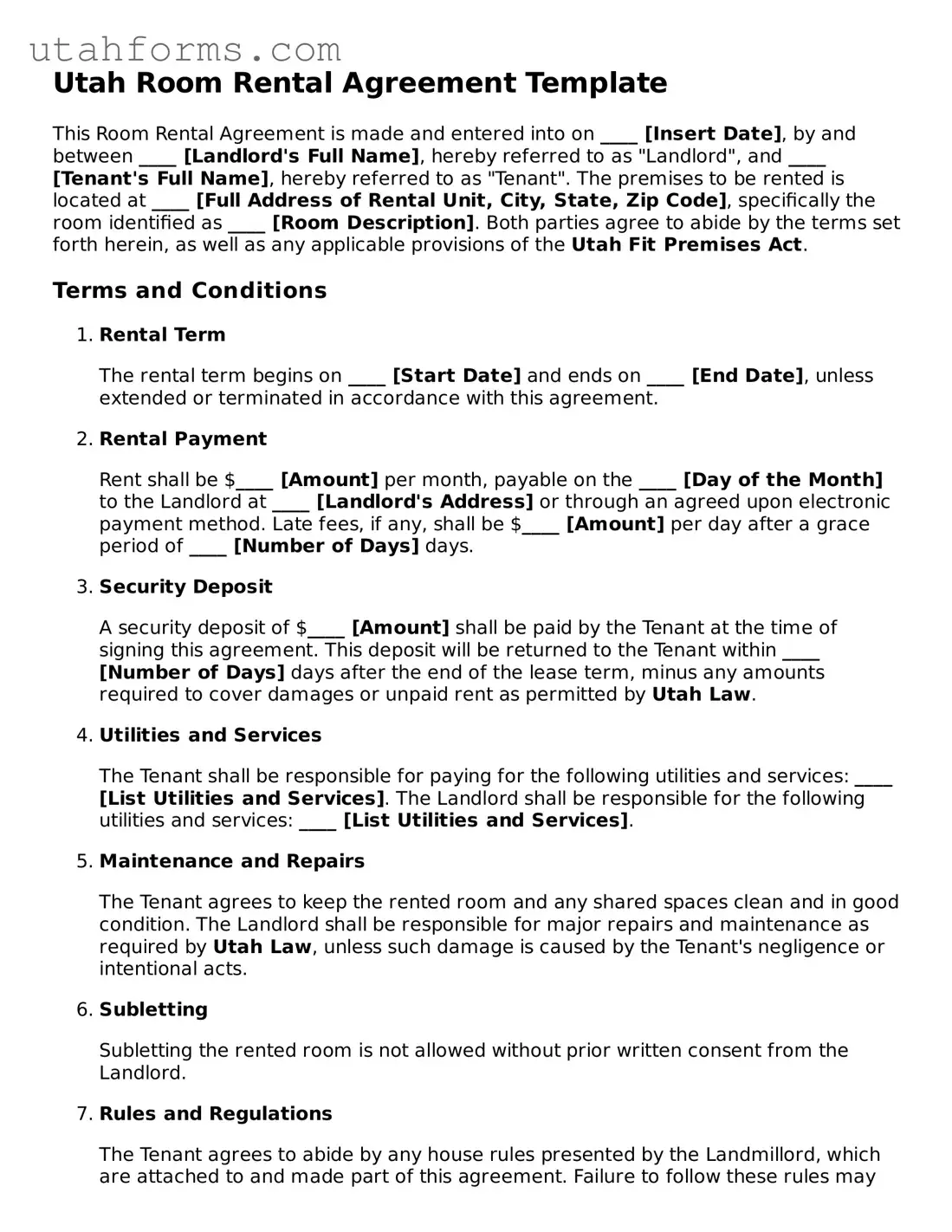The Utah Room Rental Agreement form is closely related to the Residential Lease Agreement, which is a contract between a landlord and a tenant for the rental of a residential property. Both documents serve to establish the terms and conditions under which a tenant can occupy a property, including rent, duration of the lease, and rights and responsibilities of both parties. The key difference lies in their scope; while the room rental agreement concerns the lease of a single room within a property, a residential lease agreement typically pertains to the rental of an entire property.
Another document that bears similarity to the Utah Room Rental Agreement is the Sublease Agreement. This type of agreement comes into play when an original tenant wishes to rent out their leased premises (or a part of it) to a new tenant. Like the room rental agreement, a sublease agreement outlines terms such as rent and lease duration. However, a sublease agreement also requires the consent of the original landlord and must ensure that the terms do not violate the original lease agreement.
The Tenant Application Form is another document related to the Room Rental Agreement. Potential tenants fill out this application to provide landlords with their personal information, rental history, and financial background. While the application form itself is not a binding contract, it's a precursor to the room rental agreement by helping the landlord select suitable tenants, similar to how a job application precedes an employment contract.
Next in line is the Co-Signer Agreement. Often associated with renters who have little to no rental history or a less stable financial situation, this document requires a third party to guarantee the rent in case the tenant fails to pay. The co-signer agreement complements the room rental agreement by providing an additional layer of financial security for the landlord, though it specifically involves a third party in the rental equation.
The Property Management Agreement is a contract that outlines the responsibilities and fees associated with a property manager’s role in overseeing rental property. While not directly related to the tenant-landlord relationship, it's relevant to the room rental agreement in that it can dictate terms regarding the maintenance and administrative duties of a property, affecting the tenant’s occupancy experience.
The Late Rent Notice closely mirrors situations that may arise during the tenure of a room rental agreement. It’s a formal document a landlord sends to a tenant when rent has not been paid on time. This document serves as a preliminary step before more severe actions are taken and highlights the consequences of breaching the rental agreement’s payment terms.
Similar to the Room Rental Agreement, a Lease Renewal Agreement is utilized when the initial term of a lease is about to end, and both parties wish to extend the tenant's stay. This document may adjust the terms of the original lease, including rent, which makes it pivotal in maintaining an ongoing landlord-tenant relationship. It simplifies the process of extending a lease without needing to draft a completely new agreement.
A Move-Out Checklist is a document that is often referenced or included at the end of a Room Rental Agreement. It outlines the conditions that tenants must meet before they leave, such as cleaning the space and completing repairs, to ensure their security deposit is returned. Both the checklist and the rental agreement work together to clarify expectations and responsibilities at the lease’s conclusion.
The Eviction Notice, a critical legal document, is employed when a tenant has violated terms of the room rental agreement, such as failing to pay rent or causing damage beyond normal wear and tear. This notice is a formal declaration that the tenant must leave the property within a specified period. Thus, it's a direct consequence of failing to adhere to the terms stipulated in the rental agreement, making it a significant part of the legal processes surrounding tenancies.
Lastly, the Security Deposit Return Letter, though it comes into play at the end of the tenancy, is intricately connected to the Room Rental Agreement. This letter details the condition of the room post-tenancy and how much of the security deposit will be returned to the tenant. It ties back to the agreement’s conditions around property care and the financial stipulations agreed upon before occupancy began, concluding the financial and legal relationship between the tenant and landlord.
